Cave paintings in India
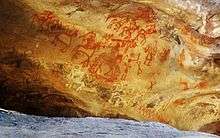
Almost all early painting in India survives in caves, as very few buildings from Ancient India survive, and though these were probably often painted, the work has been lost. The history of cave paintings in India or rock art range from drawings and paintings from prehistoric times, beginning around 30,000 BCE in the caves of Central India, typified by those at the Bhimbetka rock shelters to elaborate frescoes at sites such as the rock-cut artificial caves at Ajanta and Ellora, extending as late as the 8th - 10th century CE.
Ancient cave Painting of Odisha
Odisha has the richest repository of rock art in the Eastern India. The state has recorded more than a hundred rock shelters with interesting evidences of rock paintings and engravings. Numerous geometric symbols, dots and lines are found along with the animals, and human paintings and engravings dating from late Pleistocene period onwards. Many of the geometric shape and patterns found in rock art of Odisha are enigmatic in nature. Painted figures have been found executed in monochrome, red and white or sometimes in combination with shades of yellow color.[1]
Gudahandi
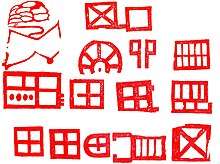
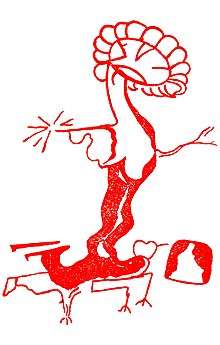
The rock shelter of Gudahandi is located on the summit of the hillock and situated about 20 km from Block headquarters Koksara in Kalahandi district[2]. The rock art shelter exhibits both monochrome and bi-chrome paintings of early historic period. It is the only reported rock art site of Kalahandi district[3]. The rock art panel preserves the specimen of paintings which include a stylized human figure in red, deer and a variety of geometric patterns of squares and rectangles either empty or in filled with straight and diagonal lines or with dots on the borders grid patterns, wheels with spokes, apsidal patterns, oval shapes with dots executed either in monochrome of red or in polychrome of red, blue and black.[4][5][6]
Yogimatha
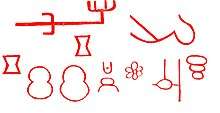
The rock painting of the Yogimatha (10th Millennium B.C.)[7] of Nuapada District of Odisha which was older script of India. The script ‘Ga’, and ‘o’ (tha) was discovered from yogimatha rock painting, this painting saw a person with four animals and write some alphabet. That painting created a word Like "Gaitha" (very popular Odia word at present ‘Gotha’ or ‘group’ in English). This art closely related to this alphabet. This alphabet has similarity to Dhauli and Jaugada Inscription’s script of Ashok. It was the ancient form of Indian script and it is the first glimpse of possible origin of the Odia language and script.[8][9]
Early medieval caves
There are known more than 10000 locations around India containing murals from this period, mainly natural caves and rock-cut chambers.[10] The highest achievements of this time are the caves of Ajanta, Bagh, Sittanavasal, Armamalai Cave (Tamil Nadu), Ravan Chhaya rock shelter, Kailasanatha temple in Ellora Caves.
Ajanta frescoes
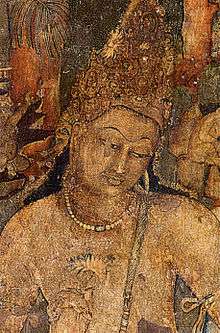
The Frescoes of Ajanta are paintings in the Ajanta Caves which are situated near Aurangabad in Maharashtra. The caves are carved out of large rocks. Inside many of the caves are frescoes.
Frescoes are paintings which are done on wet plaster in which colours become fixed as the plaster dries. The Ajanta Frescoes have a special importance of their own. They are found on the walls and ceilings at Ajanta. The paintings reflect different phases of Indian Culture from jain tirthankar mahaveer's birth to his nirvana[11] in the 8th Century AD.
The frescoes have degraded slightly, due to the effect of flash photography. Photography here is not banned. They depict themes of court life, feasting, processions, men and women at work, festivals, various natural scenes including animals, birds and flowers. The artists used shading to give a three-dimensional effect.
1500m away to the north of Ajanta, beautiful frescoes have been found. Though the themes in these paintings are both secular and religious, they do depict some aspect of Buddhist life and rituals. One of the most famous paintings show a procession of elephants. Another depicts a dancer and women musicians. These have been influenced by Ajanta style of paintings. These frescoes show a strong resemblance to the frescoes of Sigiriya in Sri Lanka.
Cave paintings in Ellora
Ellora Caves are located about 18 miles from the city of Aurangabad in Chamadari Hills. Pre-historic paintings were actually engraved in five Ellora caves. Ellora Paintings can be organized in two series. The first set of paintings depicts images of Goddess Lakshmi and Lord Vishnu and was developed while the caves were engraved. The second set of images focuses on images of Lord Shiva with his followers, Apsaras etc and was developed centuries later from the formation of caves. This caves are naturally design by the people. With there great effort we are able to see such a beautiful cluptures.
Cave paintings in Bagh
Bagh Caves are located in Dhar District of Madhya Pradesh on the banks of river Baghani. There were originally 9 caves cut in the lofty hills but only 4 of them are destroyed. The paintings in these caves were engraved in the time period of 500 AD to 700 AD.
Notes
- ↑ Padhan, Tosabanta. Glimpses of the Rock Paintings and Rock Engravings in Odisha. New Delhi: New Bharatiya Book Corporation. p. 321.
- ↑ "Rock Art Shelter of Gudahandi" (PDF). INDIRA GANDHI NATIONAL CENTRE FOR THE ARTS.
- ↑ "Districts Gazetteers(Kalahandi)" (PDF). Government of Odisha.
- ↑ Prusty, Subrat Kumar (2010). BHASA O JATIYATA (1 ed.). Bidyadharpur, Jajpur: with finical assistance by Dept. of Culture, Govt. of Odisha,. p. 22.
- ↑ Debi Prasanna Pattanayak; Subrat Kumar Prusty (2013). A Report on classical status of Odia Language (1st ed.). Bhubaneswar, Odisha: Department of Culture, Govt. Of Odisha. p. 90.
- ↑ Debi Prasanna Pattanayak; Subrat Kumar Prusty (2013). CLASSICAL ODIA (1st ed.). D-82, Maitri Vihar, Chandrasekharpur, Bhubaneswar, Odisha, 755001: KIIS Foundation, New Delhi,. p. 33. ISBN 978-81-925616-3-9.
- ↑ Senapati, Nilamani, I.C.S (1971). "History". Orissa District Gezetteers. Bhubaneswar: Government of Orissa: 35.
- ↑ CLASSICL ODIA IN HISTORICAL PERSPECTIVE. Sanskruti Bhawan, Bhubaneswar-14, Odisha: Odisha Sahitya Akademi. 2015. p. 38. ISBN 978-81-7586-198-5.
- ↑ "Rock Art Shelter of Jogimath" (PDF). INDIRA GANDHI NATIONAL CENTRE FOR THE ARTS.
- ↑ "Ancient and medieval Indian cave paintings - Internet encyclopedia". Wondermondo. 10 June 2010. Retrieved 10 June 2010.
- ↑ (Mahaparinirvana was the time of Gautama Buddha's death. His disciples scattered his remains in many places, where Stupas were erected.)
References
- Total History and Civics. a history Textbook. Published by Morning Star Publishers. ICSE Std IX.
Further reading
- B. B. Lal (1968). Indian Rock Paintings: Their Chronology, Technique and Preservation.
- Jagat Pati Joshi; D. K. Sinha; Braj Basi Lal (1997). Facets of Indian Civilization: Prehistory and rock-art, protohistory: Essays in Honour of Prof. B.B. Lal (Vol. 1). Aryan Books International. Retrieved 9 August 2013.